
Pioneer Village Town Center
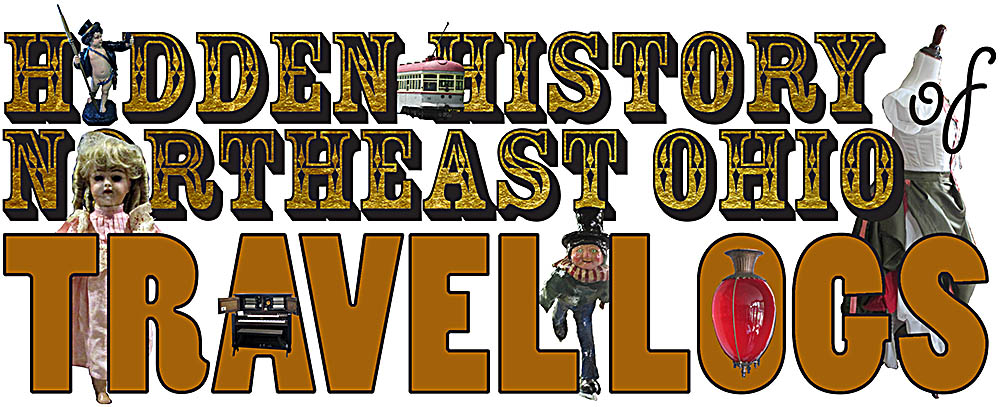
Visitor's Center
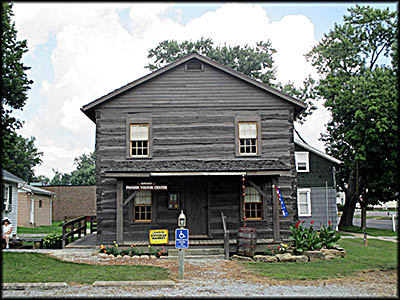
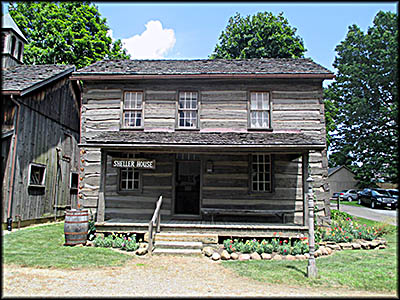
Sheller House
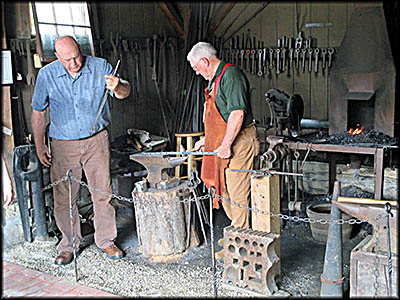
Blacksmiths
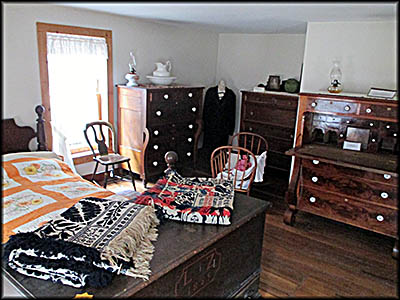
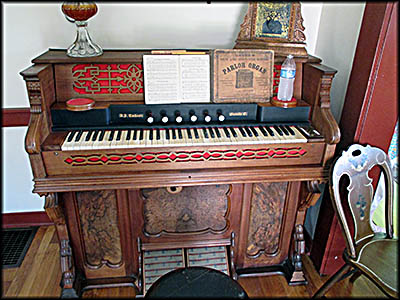
The Pioneer Village Town Center is a living history museum meant to give visitors of sense of how people lived in a nineteenth century village. It’s composed of historical buildings mostly brought from elsewhere, although at a glance you wouldn’t know it. It has a uniform feel with homes and businesses one would expect to see from that era. The day I visited, the blacksmiths did a demonstration and explained how those of their profession once worked. They made me an iron dinner bell triangle for a very modest price. Near their shop is a potter who has a wide arrange of his wares on display. Beside his shop were two ladies demonstrating their dulcimers, which is an instrument played by hitting its strings with small hammers.
It is best to start at the Downey Pioneer Visitors Center that houses a small museum filled with Native American artifacts, an impressive collection of Abraham Lincoln memorabilia, and an exhibit about the Chautauqua, a type of event whose history is outlined in detail in my book Hidden History of Northeast Ohio in the chapter about Wayne County. The museum had an interesting exhibit about Sayre’s Grocery Store in Smithville, a beloved component of the village’s community that offers a nice snapshot of the lives of several generations of a family living in an Ohio village in a largely rural area.
The store was started by Samuel Sayre. After moving to Smithville in 1928 from Quaker City, a village about eighty-seven miles to the south, this former railroad worker bought Walter Peppard’s meat market. He set up shop in a three room building in which meat was put on ice for lack of refrigeration and where one of his sons, Delbert, recalled grinding bones to make feed for silver foxes and grit for chickens. Outside a smokehouse was used to cure hams and bacon.
Although the store’s focus was meat sales and processing, in the early 1930s Samuel put up a few shelves for groceries. Despite being in the midst of the Great Depression, in 1936 he was able to buy a brick building that housed an expanded grocery store in one half and a post office in the other. The upstairs served as the family’s home. At this time Samuel became a member of the Independent Grocers Alliance (IGA) with which the store stayed until IGA decided to only serve large stores.
The store was started by Samuel Sayre. After moving to Smithville in 1928 from Quaker City, a village about eighty-seven miles to the south, this former railroad worker bought Walter Peppard’s meat market. He set up shop in a three room building in which meat was put on ice for lack of refrigeration and where one of his sons, Delbert, recalled grinding bones to make feed for silver foxes and grit for chickens. Outside a smokehouse was used to cure hams and bacon.
Although the store’s focus was meat sales and processing, in the early 1930s Samuel put up a few shelves for groceries. Despite being in the midst of the Great Depression, in 1936 he was able to buy a brick building that housed an expanded grocery store in one half and a post office in the other. The upstairs served as the family’s home. At this time Samuel became a member of the Independent Grocers Alliance (IGA) with which the store stayed until IGA decided to only serve large stores.
Delbert worked at the store until being drafted into the army in 1942. Just twenty-two at the time, he served with the Ninety-ninth Infantry Division in Europe where he participated in the fight to liberate France and Belgium, then invade Germany. He fought in the Battle of the Bulge, Germany’s unexpected last offensive on the Western Front that pushed hard into the Allies until it literally ran out of gas. After Germany’s surrender, Delbert fully expected to be sent to the Pacific to fight the Japanese, but the dropping of the atomic bombs put a stop to that for which he was glad.
After the war he returned home to his father’s store. When Samuel died in 1953, Delbert and his wife, Fern Gingery, took over. In 1961 they built a larger building and stopped allowing people to buy groceries on credit. In 1981 Delbert sold the business to his son, Glen, though he continued to work there. In July 1997 Glen’s daughter, Judy, took over. The store, now called Sayre’s Food Center, still exists, although Judy sold it to someone outside the family in 2013.
After the war he returned home to his father’s store. When Samuel died in 1953, Delbert and his wife, Fern Gingery, took over. In 1961 they built a larger building and stopped allowing people to buy groceries on credit. In 1981 Delbert sold the business to his son, Glen, though he continued to work there. In July 1997 Glen’s daughter, Judy, took over. The store, now called Sayre’s Food Center, still exists, although Judy sold it to someone outside the family in 2013.
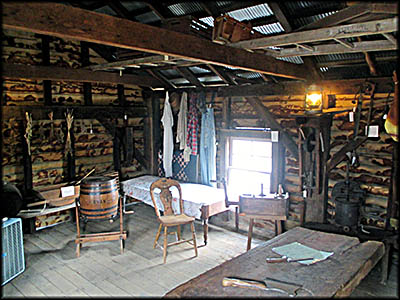
Inside the Spring House
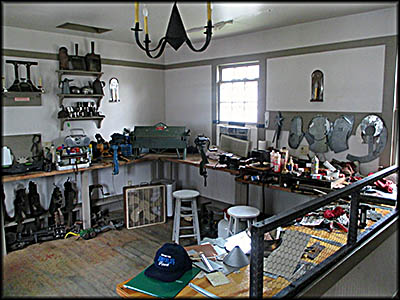
Inside the Tinsmith's Shop
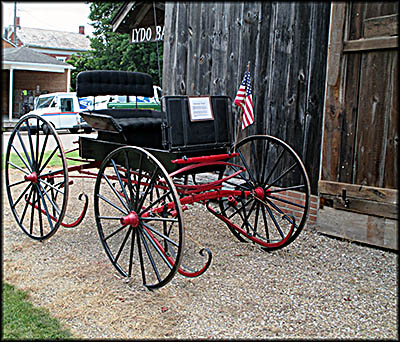
Buggy
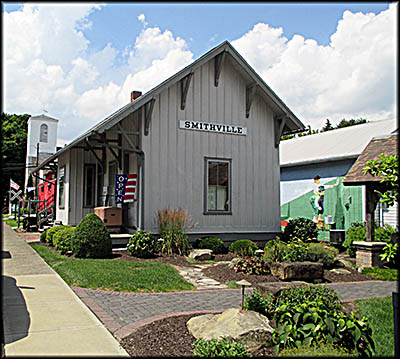
Railroad Depot
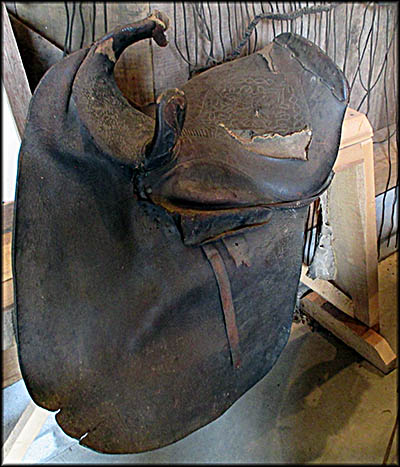
Side Saddle
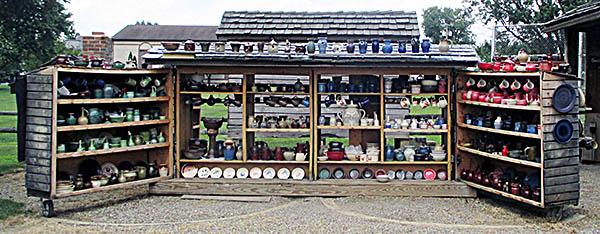
Pottery Shop's Outdoor Display
Each of Pioneer Village’s buildings has a story tell. The John Winkler Springhouse was built in 1845. In its original location it offered a reliable source of drinking water. Inside is a stone trough in which perishable items such as milk were placed to keep them refrigerated. The spring kept the whole building naturally cool, making it the perfect place to store foodstuff in barrels, jars and crocks. On the upper floor there are a variety of kitchen and food production implements. These include an apple separator made around 1843 used to make apple butter, a grape stomping vat, a cream separator, and a fruit press. On the walls one can find nineteenth century recipes. One for sausage called for twenty-five pounds of meat, one cup of salt, four tablespoons of brown sugar, three teaspoons of pepper, and three teaspoons of sage.
Entertainment was self-made, as evidenced by the still working pump organ that, when a volunteer started playing it, enticed a little girl to sing “Twinkle Twinkle Little Star.” Although a log cabin, this house was never some crude structure thrown up to serve as shelter until something better could be built but rather as a permanent home divided into multiple rooms with hardwood floors. Upstairs is a loft where the family slept.
Among the items on display upstairs are wedding dresses from three generations of a Smithville family. The oldest was worn by Maud Richeson when she married Francis J. Drushel sometime in the latter part of the 1800s. The next dress was worn by her daughter, Osie, who married on October 27, 1928. The third was worn by Maud’s granddaughter, Francis Feusier, who married on June 27, 1953. It cost $75, the equivalent of about $725 today. Being no fan of the wedding-industrial complex, I find it refreshing that the first two dresses were repurposed for use on Sundays.
Among the items on display upstairs are wedding dresses from three generations of a Smithville family. The oldest was worn by Maud Richeson when she married Francis J. Drushel sometime in the latter part of the 1800s. The next dress was worn by her daughter, Osie, who married on October 27, 1928. The third was worn by Maud’s granddaughter, Francis Feusier, who married on June 27, 1953. It cost $75, the equivalent of about $725 today. Being no fan of the wedding-industrial complex, I find it refreshing that the first two dresses were repurposed for use on Sundays.
Just down the street from the main museum complex is a red caboose and railroad depot. The former was built in 1926 and now houses a collection of antique toys. As an added bonus, on the hot day I visited, its air conditioning was a relief. The depot, also air conditioned, once served the Wheeling & Lake Erie Railroad. Built in 1881 when the railroad came through town, one of the its rooms serves as a working carpenter’s shop and the other is set up to show how the depot operated. Also here is a small exhibit about shoes and shoemaking, presumably here because shoe shiners often worked at railroad stations.
Near Pioneer Village and also run by the SCHS is the Mishler Weaving Mill, a Model T Museum, and the Heritage Center. The mill was built by John and Rosina Beveler Mishler, who in 1882 emigrated with their three children from Schwarzenberg, Switzerland, to America. Arriving in New York City, they first settled in Dalton, Ohio, then moved to Smithville where the mill was built to produce woven rugs. The Heritage Center is housed in a building that the Mishler family used as a workshop and garage. The Model T’s are part of an exhibit made possible in partnership with the Greater Akron Ford Model T Club. When planning a visit, make sure you have enough time to see both the places here as well as Pioneer Village.🕜
Near Pioneer Village and also run by the SCHS is the Mishler Weaving Mill, a Model T Museum, and the Heritage Center. The mill was built by John and Rosina Beveler Mishler, who in 1882 emigrated with their three children from Schwarzenberg, Switzerland, to America. Arriving in New York City, they first settled in Dalton, Ohio, then moved to Smithville where the mill was built to produce woven rugs. The Heritage Center is housed in a building that the Mishler family used as a workshop and garage. The Model T’s are part of an exhibit made possible in partnership with the Greater Akron Ford Model T Club. When planning a visit, make sure you have enough time to see both the places here as well as Pioneer Village.🕜